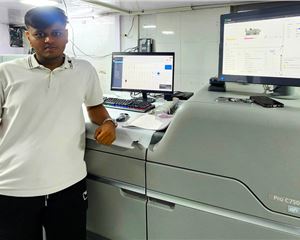India’s top hundred brands: Samsung and Nestle are the top two - The Noel D'Cunha Sunday Column
The average disposable household income
per person in India in 2017 was USD 1,948 up from USD 1,670 in 2016.
Interestingly, Indian consumers allocate 13.5% of their monthly budgets to food and beverage, 11.3% to education, and 8.4% to communication services.
These are the drivers of print. Prasad Sangameshwaran, editor of Campaign India, which published the Top 100 brands in India says,
“Consumer electronics and shopping brands dominate India’s top 10, with other brand moves indicating Indians aren’t prioritising health yet to the extent some headlines might suggest.”
In this Sunday Column, we share India’s top hundred brands
27 Jul 2018 | By Noel D'Cunha
Companies spend the best part of their budget on their most valuable asset – brand. According to a market research company, brands account for 30% of the stock market value of the businesses. For some, brands inspire loyalty. For others, it becomes a marker of distinction where products are not very different.
The Top 10 brands in India
|
Ranking |
2017 |
2018 |
|
1 |
Samsung |
Samsung |
|
2 |
Nestlé |
Nestlé |
|
3 |
Sony |
LG |
|
4 |
Apple |
Amul |
|
5 |
Amul |
Sony |
|
6 |
LG |
Apple |
|
7 |
Big Bazaar |
|
|
8 |
Philips |
Big Bazaar |
|
9 |
Adidas |
Philips |
|
10 |
Apollo |
Amazon |
In the list, Samsung has retained the number one position it held last year. There was much fanfare on 9 July when prime minister Narendra Modi and South Korean president Moon Jae-in jointly inaugurated Samsung’s largest mobile factory in the world. This Noida unit will double the company’s output to 120 million units in the next few years. The company also regained the top market share in the Q2 with a 29% share against its closest rival Xiomi’s 28%.
Prasad Sangameshwaran, the editor of Campaign India, says, “Across Asia, and in India, Samsung dominates the rankings as the brand continues to occupy pole position for the third consecutive year. But the real gainer in the Top 10 was Samsung’s Korean ally, and close competitor, LG, which jumped three spots over the previous edition of the study to sit pretty on the third position.” He adds, “A marketing expert feels that while Samsung is on a strong wicket because of the wide range of products it has on offer, it has its work cut out in key categories like mobile phones – where the brand was under fire when its premium phone model had serious problems and had to be recalled.”
Also, competitors like Xiaomi, OnePlus and others have made serious inroads into what was considered an impregnable fortress.
Nestlé too retained its second spot. The FMCG major’s market cap crossed the Rs 1-lakh crore mark recently. However, the company failed to protect Kit Kat’s four-finger bar shape in a legal war it has been waging with US rival Mondelez.
Consumer electronics and durables dominated the conversation among Top 10 rankers in India with five out of the top 10 brands belonging to that space.
Sony slid to number five and Apple to number six, while India’s Amul found a spot in Top 10.
Before the FIFA World Cup 2018, Sony India had targeted a sales growth of 20% in 2018. It is now taking the football world cup success ahead with a 35% increase in sales for the Onam season in Kerala.
Apple has seen a sharp fall in the shipments in the first half of 2018. With a 55% drop in the June quarter compared to the previous year, experts say, Apple is staring at one of its toughest years in India. Profitability over growth by cutting discounts and distribution are cited as reasons for the drop in sales. But Apple is one company which inspires loyalty, and consumers still die for Apple. How will it fare next year, only time will tell.
The surprise, however, has been Philips. “The brand was once synonymous with consumer electronics in India. Now, it is relegated to niche space of lighting, male grooming, healthcare, among others,” says Sangameshwaran. Yet, the brand continues to hold its position in Top 10 for the second consecutive year. At number nine, Philips is one spot ahead of even Amazon. “In 2016, Philips was at number 18, which now belongs to Japanese major Panasonic,” Sangameshwaran adds.
The Top 1000
While Big Bazaar and Amul are the only Indian brands in Top 10, another eTailer Amazon also has a spot. “It’s driven by Indian consumers’ love for shopping and bargain hunting,” says Sangameshwaran. However, internet video on demand services provider Amazon Prime Video lags behind at number 77. Netflix, however, has not made it to the top 100. “That’s a surprise,” says Sangameshwaran.
In the financial services sector, blame it on the rising NPAs or growing concern on governance in the banking sector, but the topmost financial services brand is not a bank, nor a mutual fund, says Sangameshwaran. Payment majors Visa and MasterCard came upfront at ranks 28 and 32 respectively. Indian bank brands sauntered in later with SBI, the country’s largest bank, at the 37th spot. ICICI Bank is even lower and occupies the 41st place.
Another surprise was even as Indians, the younger set, in particular, are getting more health conscious, we are not going to give up our indulgent foods in a hurry. “How else would one explain the fact that both Maggi and Coca-Cola are doing well in the study,” says Sangameshwaran, though he says, both the brands had to face a considerable amount of consumer ire when they fell foul with the government, allegedly over consumer quality issues. Does this show that the Indian consumer has given up on healthy eating? asks Sangameshwaran. Well, the fact that cab aggregators like Ola and Uber came well ahead of sports shoe manufacturers throws a strong indication where the preference lies.
The Indian brands
Campaign Asia-Pacific's Asia's Top 1000 Brands survey for 2018 research points to Tata, Patanjali, Flipkart, Amul and Reliance as the most popular local brands in India. Chandramohan Mehra, CMO, Bajaj Allianz Life Insurance, says, “These brands have been able to deliver value on a sustainable basis. These values encompass trust and quality. They continue to meet the proportionate price-perceived-value equation and have a powerful emotional connect.”
Praful Akali, founder and managing director, Medulla Communications, feels that a lot of these brands give you a sense that the product comes first. “That's a clear advantage the local brands have over the MNCs. How these products fulfil inherent consumer needs is the secret of their success,” he says.
Finally, it was predicted that eCommerce will eliminate brands. That has not happened because, and as can be seen, consumers are looking for good products at a good price, and brands have been able to provide that.
For the complete list of India’s Top 100 brands, visit https://www.
(With inputs from Campaign India’s editorial team)












 See All
See All